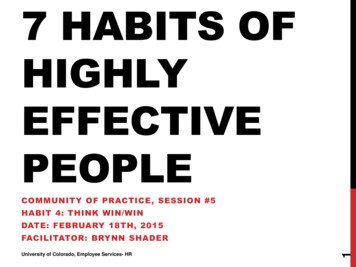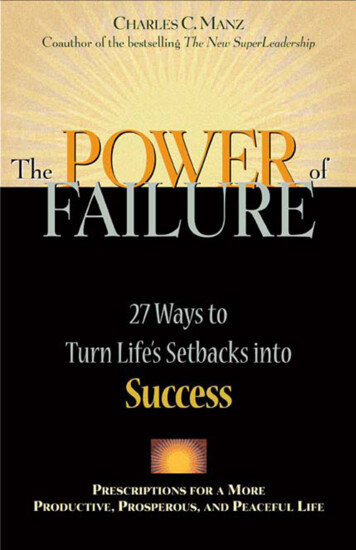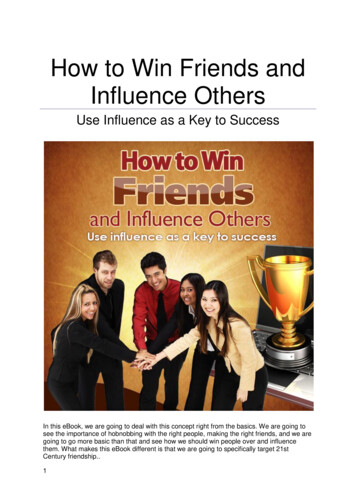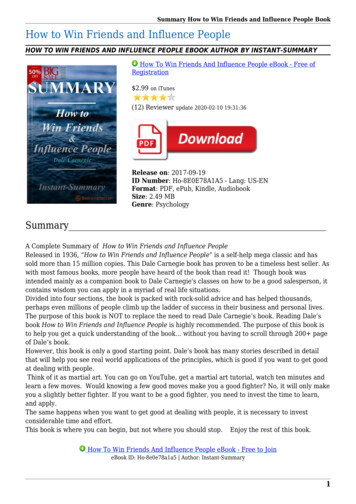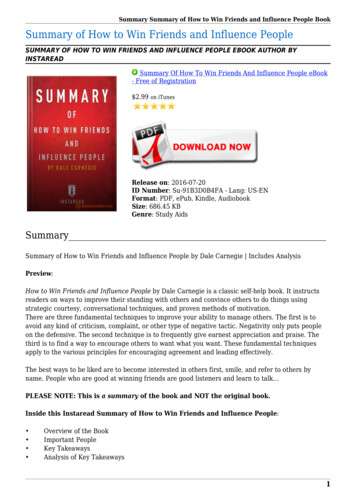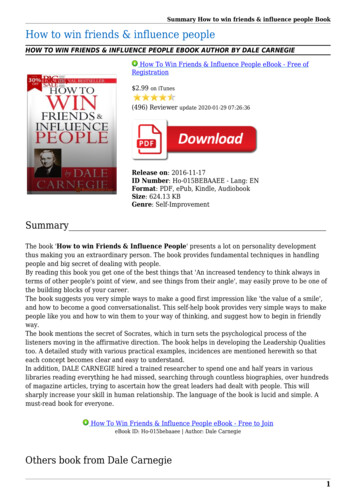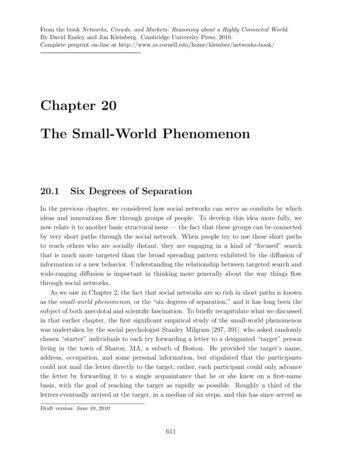
Transcription
How to Win Friends and Influence PeoplebyJess WheelockBachelor of Fine ArtARCHIVESCleveland Institute of Art, 2008Submitted to the Department of Architecture in Partial Fulfillment of the Requirements of theDegree of Master of Science in Visual Studiesat theMASSACHUSETTS INSTfffUTEMassachusetts Institute of TechnologyOF TECHNOLOGYJune 2010JUN 0 9 2010LIBRARIES 2010 Jess Wheelock. All rights reserved.The author hereby grants MIT permission to reproduce and to distribute publicly paper and electroniccopies of this thesis document in whole or in part in any medium now known or hereafter created.Signature of A uthor: .Department of ArchitectureMay 20, 2010Certified by: .-----v--.-.--------- - --- r:----------.-:'-O) ------.-a-Joan JonasProfessor of Visual ArtsAccepted by: .Julian BeinhartProfessor of ArchitectureChair of the Department Committee on Graduate Students
How toWin FriendsandInfluence PeopleJess WheelockSubmitted to the Department of architecture on May 20, 2010in partial fulfillment of the requirements of theDegree of Master of Science in Visual Studies.
THESIS ADVISOR: Joan JonasTITLE: Professor of Visual ArtsMASSACHUSETTS INSTITUE OF TECHNOLOGYTHESIS READER: Wendy JacobTITLE: Visual Arts Lecturer, Director of Autism StudioMASSACHUSETTS INSTITUE OF TECHNOLOGYTHESIS READER: Gediminas UrbonasTITLE: Associate Professor of Visual ArtsMASSACHUSETTS INSTITUE OF TECHNOLOGYSPECIAL THANKS TO:Catherine McMahonJeremy WheelockandJoe Zane
AbstractMy thesis work developed out of a specific book: How to Win Friends and InfluencePeople by Dale Carnegie. The book is one of the best-selling self-help books of all time. Everypart of the book was material for my project: The words. The author. The style. The physicalobject. I also use myself, the reader as a material. These materials can be manipulated likepaint or clay or wood. But materials have limitations and resistances. That's what makes thewhole thing interesting. In fact, it was my material resistances - my shyness, my nervousness which led me to begin working with How to Win Friendsand Influence People in the first place.My thesis project, How to Win Friends and Influence People is an animation and seriesof sculptural props that examines Dale Carnegie's book.The written thesis will explorenotions of performance, humor, anxiety, and the self as they appear in this project and myprevious work completed here at MIT. It will also explore my art in more general way. Whatis my process as an artist? How do I make decisions? Who do I make them for?And here it is. I hope you like it.11Dale Carnegie. How to Win FriendsandInfluence People. (New York: Simon & Schuster 1964)xvii. "Since no such book existed, I have tried to write one for use in my own courses. And here it is.I hope you like it."
ContentsHow This Thesis Was Written - and WhySuggestions on How to Get the Most Out of This BookPART ONE: PROJECT DOCUMENTATIONFundamental Techniques in Handling PeopleHow to Win Friends and Influence PeopleProject DescriptionThe Animation: Script, Stills, and StoryboardsSculptural PropsPART TWO: THOUGHTS AND REFLECTIONSFive Ways to Make People Like YouPlaying With a Lack of ControlThe Secret of SocratesIf You Don't Do This, You Are Headed for Trouble
How to Interest People61When Nothing Else Works, Try This65PART THREE: OTHER WORKSHow to Win People to Your Way of ThinkingPushing Back Avalanches71Carry that Weight75Burning the Candle at Both Ends79Balancing Act83Precautions87Ah GUzel istanbul (Oh Beautiful Istanbul)95Self-portrait as a stack of books99Works Consulted101
10
How This Thesis WasWritten-and WhyBlank pages. That's what you start with when you begin to write a thesis. A blankpage is daunting because it is filled with expectations. Expectations can be paralyzing. Howdo you even begin? You've got to make a good first impression. It's funny how much you canworry about something that only a handful of people may ever read.So how do I begin? Let's begin with the book. My thesis work developed out of aspecific book: How to Win Friends and Influence People by Dale Carnegie.2This is also thetitle of my thesis. How to Win Friends and Influence People is one of the best-selling self-help2 Dale Carnegie wrote How to Win Friends andInfluence People in 1937. One of the first bestsellingself-help books, it has sold roughly 15 million copies and has been translated into almost everyknown written language. The publishing company, Simon & Schuster writes the following on thejacket cover: "As Carnegie explains, the majority of our success in life depends on our ability tocommunicate and manage personal relationships effectively, whether at home or at work How to WinFriends andInfluence People will help you discover and develop the people skills you need to live welland prosper. "People often ask me if I really read the book. Of course I did. I really enjoyed it.
books of all time. Every part of this book was potential material for my project: The words.The author. The style. The physical object. I also use myself, the reader, as a material. Thesematerials can be manipulated like paint or clay or wood. But materials have limitations andresistances.That's what makes the whole thing interesting.In fact, it was my materialresistances - my shyness, my nervousness - that led me to begin working with How to WinFriendsand Influence People in the first place.For my project -- an animation and series of sculptures called How to Win FriendsandInfluence People -- I decided to act out Dale's book. In the animation, I fall into the text andam mentored by Dale Carnegie, who gives me advice and some absurd tools to help me dealwith people. Through the process of making, I inhabited Dale's book and populated it withmy own intentions.I hope you're not offended if I sometimes have a conversational tone to my writing.This too was inspired by Dale Carnegie. It's easy for words to confuse and obscure an idea.Dale proves that eloquent thoughts can be delivered in a frank and straightforward manner. Arelaxed tone should not imply a lack of precision.3My intention is to be reflective andprobative, not authoritative and omniscient. If I appear to wander, please keep in mind thatit is curiosity -- the desire to know-- that takes me off of the fixed path. 4 I have learned frommaking art that wandering is a good way to discover something.3 French filmmaker Yves Lavandier notes in his book Writing Drama (pp. 316-326), "Although theapparent lightness of comedy may lead us to believe that it is written easily, it is, in fact, the hardest ofthe styles to master. Comedy needs careful handling and requires a certain amount of technique.There are fewer constraints involved in being serious than in being funny."4 Giuliana Bruno, Atlas ofEmotion: Journeys in Art, Architecture, andFilm. (New York: Verso, 2002)156. Bruno is a Professor of Visual and Environmental Studies at Harvard University. She writes inAtlas ofEmotion (pp. 156), "Curiosity came to signify a particular desire to know, which, for aperiod, was encouraged constantly to move, expanding in different directions. Such cognitive desire
My written thesis, How to Win Friendsand Influence People, negotiates and plays withthe text and chapters headings of the original book. This was a way for me to make fun withmy thesis. I believe that thoughtful and rigorous tasks -- like writing a thesis -- can be fun. Infact it this type of work, which has been attributed with a certain importance, that sodesperately needs some good goofing-off. As Kristin Stiles writes, "Goofing-off requiresdeveloping a fine-tuned sense of what it means to pause long enough and distance oneself farenough from wordly objects and events to recognize their illusory dimension and therebyreinvest the world with wonder."5 And she should know, she's an art historian.implies a mobilization that is drift. It is not only implicated in the sensation of wonder, as is oftennoted, but located in the experience of wander."5 Kristin Stiles. "Fluxus Performance and Humour." The Artist'sJoke, ed. Jennifer Higgie(Cambridge: MIT Press, 2007) 52. Kristine Stiles is Professor and Director of UndergraduateStudies in the Department of Art, Art History, and Visual Studies at Duke University. Stiles explains(pp. 54), "I have lingered long on the earnest values of goofing-off because the ability to balance selfabandon and self-awareness in self-oriented activity is part of the ontology of Fluxus performance.
Dale Carnegie says that his book is an action book.6 You won't really learn from thebook unless you try it out. As an artist, I too believe in action: making, causing, and doing asa way to know and shape the world. My thesis is a reflection on action. It will examinenotions of performance, humor, anxiety, and the self as they appear in my project How to WinFriendsand Influence People and previous work completed in my time here at MIT. But it willalso explore my art in more general way. What is my process as an artist? How do I makedecisions? Who do I make them for?And here it is. I hope you like it.7Such a delicate tension holds the potential to increase personal growth and at the same time recognizesthat the self belongs to institutions and phenomena larger than that self."6 Dale Carnegie. How to Win Friends and Influence People. (NewYork: Simon & Schuster 1964)xxi. Carnegie quotes the British philosopher Herbert Spencer who says, "the great aim of education isnot knowledge but action."7 Carnegie xvii. "Since no such book existed, I have tried to write one for use in my own courses.And here it is. I hope you like it."
Dale Carnegie from LIFE Photo archive and a sketch from How to Win Friends andInfluence People.
16
Suggestions on How to Get theMost Out of this BookBuster Keaton taught me how to read a book.8 Well, he didn't exactly teach me howto read, but Buster did teach me how to watch a movie - which is how I began re-imaginingthe act of reading a book.In the 1924 silent comedy Sherlock Jr., Buster plays a film projectionist who fallsasleep while screening a movie.9His dream state "double" exits his sleeping body andwanders into the film Heartsand Pearls. In the world of the movie, he becomes "Sherlock Jr."- a detective determined to solve a crime that eerily mirrors the young projectionist's real-lifeproblems. The actors in the movie transform into people he knows: his sweetheart and theFrank "Buster" Keaton, 1895-1966. Buster Keaton was an American comic actor anddirector famous for his silent movies produced between 1920-1929 that often incorporated slapstickgags. My work has been influenced by his physical comedy and silent, dead-pan character. So BusterKeaton not only taught me how to read a book, but also how to fall down.9 Buster Keaton, director. Sherlock Jr., 1924.8 Joseph
awful cad who is trying to get between her and Buster. Through the device of the dreamstate, Buster's character projects himself -- his inner vision - into the movie, thus alteringboth the movie and himself.The surrealist painter and filmmaker Salvador Dali referred to Buster's work as"concrete irrationality" due to the imaginative use of the body as a tool for physically actingout an absurd idea. This concreteness allows his comedy to break the bonds of logic. " Bygetting up and walking into the film, Buster transforms the emotional journey of a moviespectator into the concrete journey. 2becomes the detective.Buster doesn't just identify with the detective; heBy using the plot of the movie, Buster literally acts out his innerconflict in concrete form. The fantasy world of the movie becomes a site to work through theirrationality of the character's real-life.I too have my own illogical impulses that I attempt to make concrete in my animationHow to Win Friends and Influence People: what would it look like if I fell into a book? Whatdoes the abstract relationship between the author and reader look like in physical form? Howdo I make the conflict between a self-help book and reader concrete?" Giuliana Bruno. Class Lecture, 5 Feb 2009. Bruno argues that cinema is a technology for visionand a mobilization of the gaze that affects the way we understand our own perception. In this way,cinema is not just about vision, but about inner vision. Film allows movement to be liberated fromthe body. Through the act of watching, the spectator may travel without the moving the body." Robert Knopf. The Theater and Cinema ofBuster Keaton (Princeton: Princeton University Press1999) 112. According to Knopf (pp. 112): Since the 1920s, surrealist artists like Salvador Dalichampioned the work of Buster Keaton and argued that his work shares aesthetic and thematicconcerns with Surrealist art of the 1920s and 1930s.12 Bruno. Bruno argues that there are mobile dynamics involved in watching a film. The spectatorisnot a static contemplator, a fixed gaze, or a disembodied eye/I. The embodied observer "is a physicalentity, a moving spectator, a body making journeys in space. .As we walk, it is our legs thatconstruct the meaning."
Buster's dream double walks into the movie screen in Sherlock Jr. (1924)19
In the project, the act of reading is translated into an animation. The pages of How toWin Friendsand Influence People is the backdrop for the imagined world inside of the book.Dale's text is the landscape. The world that Jess falls into follows the rules of reading a book.Dale, the author, can speak to her - but only using dialogue straight from the book. Jess, thereader, cannot speak back to Dale: she can only listen. Although she cannot speak, Jess isrotoscoped, which makes her action more fluid and gives her voice through body language."Dale is animated using a cutout stop-motion technique, which makes his movement stiff and abit clunky. 4Dale and Jess literalize the notion of "catching someone'sinterest" by fishing. How to Win Friends and Influence People(2010).Rotoscoping is an animation technique in which the animator traces over live action footage. ForJess, I shot footage of myself and made a pencil drawing over it.14 Stop motion is an animation technique in which one makes a physicallymanipulated object appearto move on its own. Dale is a cutout figure that I animated by moving him frame by frame.13
Despite these rules, there is still room to play with the world inside of How to WinFriends and Influence People. Dale's words and advice may be misinterpreted as it is reimagined through the act of "reading." In the animation Dale acts as Jess's mentor. But I, theartist, am able to manipulate his advice by making it literal and absurd.As Jess wakes up at the end of the animation, Dale cries: "It's all in your head Jess!It's all in your head!" This is true. It is all in my head. In a way, Dale is like the ventriloquistdummy. In a ventriloquist act, the puppeteer and the dummy are really two halves of the samewhole. The dummy allows a single person - me - to externalize an internal dialogue. The"conversation" between Dale and I is really my own conflict with social performance anddecorum. Is it ok to not be ok?Buster and Jess reading in Sherlock Jr. (1924) and How to Win Friends and InfluencePeople (2010) respectively.
22
Part One: Project DocumentationFundamental Techniques inHandling People
24
How to Win Friends and InfluencePeopleHow to Win Friends and Influence People is an animation and series ofsculptural props that examines Dale Carnegie's book of the same title.In the animation, I fall into Dale Carnegie's book and am mentored by theauthor. Dale gives me advice and some absurd tools to help me deal with people. Ithen recreate the tools from the animation in sculptural form. The project plays withthe self-help genre by testing out the etiquette of getting ahead and the peculiar rulesthat govern social interaction.
26
The Animation:Script, Stills, and Storyboards[Jess is reading How to Win Friends and Influence People.toe-roW1EICOLC CA[ She yawns and appears to be tired. Eventually, she falls asleep, slamming her head into thebook. ][ Jess falls into the book. ]
DALE: Hello Jess. It's me, Dale Carnegie. Come on in! It's time for you to learn how to winfriends and influence people.[ The page turns.IDALE: First things first! You've got to make a good first impression, Jess. You've got to smile.You see Jess, actions speak louder than words and a smile says: "I like you. You make mehappy. I am glad to see you." Some folks just don't know how to smile. It's truly a shame.Why don't you give it a try, Jess?[ Jess tries to smile. ]DALE: Oh, uhhh.well.that's a good start.I guess.Listen Jess, you've got to act as if you're already happy, and that will make you happy.[ Dale hands Jess a smile stick. ]Here, try this, it'll make things easier.
[ The page turns. ]DALE: Now Jess, you're pretty quiet, but that's what's going to make you a greatconversationalist.[ Dale turns on the record player. Words come out of the phonograph.]DALE: You see, People don't realize how important it is to listen to other people. The secret isto encourage other people to talk about themselves.that's what they find fascinating! That'swhat they want to talk about![ Record stops. ]DALE: Here try this.[ Dale hands Jess a large ear.]DALE: They're going to want to spend more time with someone who really let's them spendtime with themselves.[ The page turns. Jess and Dale are fishing on a boat. ]DALE: Personally Jess, I'm very fond of strawberries and cream, but for some reason fish preferworms. When you go fishing, you can't think about what you want. You've got to think aboutthis fish. What do they want? Why not use that same logic when you're fishing for people?
[ The page turns. Dale and Jess are sitting and drinking beers.]DALE: A lot of people wonder why I wrote the book.and I'm going to tell you the truth, Jess. I'mnot crazy about people. Dealing with people is probably the biggest problem I have in my life.Why, I was the one of the unhappiest lads in New York.I feel like we're all playing this big game -- but how can you win? There's no handbook. So Ithought to myself: I'm going to make the handbook. I decided to undertake a systematic study ofevery practical idea that everyone has ever had, down through the ages for winning friends andinfluencing people.And here it is. This is it. I hope you like.[ Jess smiles with her smile stick. ]
[ Jess gets up and turns the page herself. Dale follows her. ]DALE: What is it, Jess? Where are we going?[Jess picks up the corner of the page and runs through the pages like a flip book. A littleanimation appears. ]DALE: Oh wow -- would you look at that! Has that been here the whole time? I've never seen itbefore.how wonderful.[The full page begins to flip, faster and faster. Jess and Dale are tossed around. ][Dale yells the following:]Everyone in the world is seeking happiness and there's one sure way to find it: happinessdoesn't depend on outer conditions -- it depends on inner conditions!It's all in your head! It's all in your head, Jess![ Jess wakes up and closes the book. ]
32
Sculptural PropsTT
Smile stick.
Speakers are embedded in the ears. The viewer uses the ears to listen tothe audio of the animation.35S
The animation plays inside of the book How to Win Friends and Influence People.
Fishing for people with a hamburger.
38
Part Two: Thoughts and ReflectionsFive Ways to Make People Like You
s.,. .,4-3age:--,,,.ac.,rrior.I,1.'. -. wa.s,--s
Playing With a Lack of ControlWho is this "Jess" that appears in my work? Is it me, the artist? Is it a character?Sometimes people confuse Jess and I because we have the same name and look alike. Even Iget confused sometimes.Artists and performers who represent themselves onstage have astrange relationship to their identities. A gap opens up between performer and performed.Even if the intention is to recreate one's offstage personality precisely, the result is still ahighly edited and crafted self that ultimately is presented for the audience. " The presence ofthe audience creates a self-consciousness that affects one's behavior.The world is full of these split person/persona performances. Joe Gibbons performsthe mad genius, outwitting the world.16 Sean Landers performs Sean, the insecure egotist. 17Andy Kaufman played Andy, the sweet (or is it obnoxious?) infantile man. 8 Andy'sStephan Kaplin. "A Puppet Tree." Puppets, Masks, andPerforminged. John Bell (Cambridge:MIT Press, 2001) 22. Kaplin examines the puppet/performer relationship by developing a diagramthat maps out the spectrum of distance between performer and object, beginning with the actor andthe character role.16 Joe Gibbons. Gibbons is an American artist and experimental filmmaker. In his 1986performance with Tony Conrad, Laughter and Defecation, Gibbons plays comedian researchinglaughter at MIT. He tells the audience: "We're not going to do the easy thing. .which would be tomake you laugh."17 Sean Landers. Born 1962. Landers is an American artist whose work often involves confessionaltext that oscillates between self-doubt and over-the-top self-assurance. Landers says in "The Booby"'5
nso emubarross*CV.Jess in There's a MONSTER at the end of this book! (2009).(1998): "My Original idea was to make conceptual art entertaining, sloppy, emotional, human andfunny. Over the years I got so far out on this conceptual limb that I went around full circle until Iwas a traditional artist again. I tried to be ironic about it but eventually became sincere. Now I'm ahappy victim of my own charade. I figure that it's better to be a sucker who makes something than awise guy who is too cautious to make anything at all."18 Andy Kaufman. 1949-1984. Andy Kaufman, one of the most perplexing figures to emerge fromAmerican stand-up comedy. At times endearing and at other points obnoxious, Andy was nationallyknown for his appearances on Saturday Night Live; the sitcom Taxi; Late Night with DavidLetterman;and The Tonight Show with Johnny Carson. As Florian Keller points out in her book, Andy Kaufman:Wrestling with the American Dream (pp. 4), despite these connections to comedy and his history ofstand-up in New York and L.A., Andy claimed to be a "a song and dance man" and denied thecategorization of "comedian" by stressing that laughter was not was what he was after. "I've neverdaimed to be a comedian. I've never claimed to be able to tell a joke."
Joe Gibbons in The Genius (1993).Andy Kaufman as "Foreign Man" doing an impression of Elvis Presley. From the LIFEphoto archive.
performances exemplify the confusion of performer and performed: where does one end andOh, you thought that was the real Andy? That' just a characterhe does: Andythe other begin?Kaufman - normal, sweet boy, and all that.performance end?That's not really Andy."When does theAndy was so successful at blurring the lines between reality andperformance that when he was dying of cancer in 1984, many thought it was another one ofhis performances. 20 This staging of the self naturally raises questions about role and reality,personality and character, having and being.'Performed Jess is more than me in the sense that she is an exaggerated version ofmyself: quieter, clumsier, and more nervous. She is less than me in the sense that she is only aninstance of my identity - a simplification. I am composed of many selves that are constantlyin dialogue with one another. Believe it or not, I can sometimes be quite talkative, confident,and sometimes--just sometimes -- I can actually be graceful. Performed Jess is asimplification and an exaggeration of me: less and more.Vito Acconci described his performance personality in a similar way: a "malecartoon."22 His maleness was a blatant and amplified aspect of his performances.2 3I toosometimes feel that I am making a cartoon of myself. Does this mean my representation is" Julie Hecht. Was This Man a Genius? (New York Random House, 2001) 12. Bob Zmuda,Andy's collaborator said this to Julie Hecht, who was interviewing Kaufman at the time.20Philip Auslander. Presence andResistance: Postmodern and Cultural Politics in ContemporaryAmerican Performance. (Ann Arbor: University of Michigan Press, 1992) 145.21 Knopf 112. Knopf examines the stand-up comediansability to evade and detach his or heridentity. He notes that (pp. 117) the, "comedian whose name is Ellen DeGeneres [is] playing acharacter named Ellen Morgan in a show called Ellen (After the character? After the star?)."22 Vito Acconci. Born 1940. Acconci is anAmerican artist and architect.23 Richard Prince. "Vito Acconci." BOMB 36 (Summer1991) 5. According to Acconci: "When Isaid that, I meant-I hope I meant-not "myself" but "myself-as-performer" in some of the earlywork, where maleness was made so blatant that it stood out like a cartoon: so then it could be targeted,it could be analyzed, it could be pilloried."
simplistic? "Simplistic" is a term often used disparagingly, but as cartoonist Scott McCloudargues in his text Understanding Comics, cartooning isn't just a way of drawing, it's a way ofseeing.Cartoons abstract an image by eliminating detail and focusing our attention onspecific points.2 4Beyond that, they allow for the viewer to identify with the cartoon.McCloud explains in comic form:APART FROM WHATLITTLE I TOLD YOUABOUT MYSELF INCAP7R OAE I'MPRACTICALLY AfflANU OWONDER WHAT MYJV41M ARE, ORWHAT I HAD FORZ4WOLRWHEREIo/GOT THo YouTo A7F1TPIEE,&WIVISZIPOT'M JUSTA LITTLE VOICEINSIDE YOURAPA CO#VCpTNFSIEYUAR NYNEARYOUGIVE ME LIFEY READING THISBOOK AND BY S/A'6SERYlAM ISIVIRRELEVANT A'MJUST A LITTLEIECE OF )WUP I'rm.MEE1WUTIF WHO OAMIMATTERSMAYBE WHATZOWILL MATTERITE4.AW,OYCEThe attention in my performances focus on the limitations and anxieties of Performed Jess.She is confronted with her own limitations and those imposed upon her by the world-but--she nevertheless struggles to move beyond them. This dramatized struggle is a very human2425Scott McCloud. UnderstandingComics (New York: Harper Collins Publishers, 1993) 31-36.McCloud 37.
thing. You don't need to drop a giant birthday cake to have experienced something sweet gohorribly, horribly wrong.26Digital sketch for Balancing Act.Jess allows me to turn myself into an object - into a material that I can play with andexamine.I refer to this relationship (between myself and performed self as self-puppetry.Metaphorically, this doesn't mean that I am a puppet master that exerts complete control26BalancingAct. See page ? for the project description.46
over my image.As puppeteer John Bell notes, complete control over an object is animpractical and ultimately boring process, especially if you are an artist.2 7Puppetry involvesan idea of control, but not the one it's typically associated with. The puppeteer actively playswith a certain lack of control. She is aware of the puppet's material structure and limitations.She experiments with different movements and embraces accidental and unforeseen motions,incorporating those possibilities into her work.28You pull on the puppet and the puppetpulls back: there is reciprocity.This is the tension between what it means to be an "object" (a thing that is actedupon) and what it means to have a "life" (something that acts).29The puppet is not just acrude object, it is performed material -- a metaphor which aligns with certain theories of thebody as an "inscripted" site.30The body is a physical object -- a blank page -- that isperformed. It is a nexus of cultural value and choice.""There are aspects of myself that I do not have a lot of control over, such as that scaredface I make when I am in front of an audience. I build these aspects of myself into PerformedJess.My limitations become the material I play with as a puppeteer. If I am too shy to speakJohn Bell The Puppet Show 17. John Bell also quotes Puppeteer Shari Lewis on the subject:"There's so much bad puppetry around because people simply decide that they're going to do apuppet, and then try toforce a character onto the puppet. And you can't force it. You have to sit infront of a mirror, and let the puppet tell you if it wants to talk." 2 7 This isn't a mystical belief in theobject, but rather a practical understanding of the material world.28 John Bell The Puppet Show1729 Gideon Haberkorn. "The Muppets as a Metaphor for the Self." Kermit Culture ed Jennifer C.Garlen and Anissa M. Graham (Jefferson: McFarland & Company, Inc., 2009) 30.30 John Bell. American PuppetModernism: Essays on the Material World in Performance (New YoricPalgrave Macmillan, 2008) 4." Judith Butler. The Judith Butler Reader (Malden: Willey-Blackwell, 2004) 105. Butler argues thataspects of identity, like gender, are performed "styles of the flesh." "These styles, she explains, are(pp. 113), "never fully self-styled, for styles have a history, and those histories condition and limitthe possibilities. Consider gender, for instance, as a corporealstyle, an 'act,' as it were, which is bothintentional and performative, where 'performative' suggests a dramatic and contingent construction ofmeaning."27
in front of a large group of people, maybe I will find another way to project my voice -through body language and narration. Maybe my nervousness can be part of that voice.Maybe I can play with the thing that embarrasses me the most.Jess as a persona is portrayed through movements, expressions, and actions. Verylittle biographical information is actually communicated about Jess.What is heroccupation? What is her sexual orientation? Did she grow up on a farm? Is she allergic topeanuts? I do not reveal this type of information. In this way, the creation of the PuppetJess does not come out of an interest in const
How to Win Friends and Influence People is one of the best-selling self-help 2 Dale Carnegie wrote How to Win Friends and Influence People in 1937. One of the first bestselling self-help books, it has sold roughly 15 million copies and has been translated into almost every known written language. .

